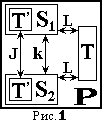FUNDAMENTAL PSYCHOLOGY ( FP )
Part I
HYPERPHYSICAL MATERIALISM
(The nature of PSYCHE)
Chapter 2. DISTANT PERCEPTION (DP)
2.1. Communicative /sensual perception (CP)
|
è
Usually, in routine practice, when a person/subject S (fig. 1) doesn't support upon his intuition, objects (phenomena) T of physical reality P are reflected in his internal, "ideal" world as images of perception T'. Adequacy of an image T'(to perceived object T) as a result r of a separate act of perception (observation, etc) – of reflection R – is always doubtful. This adequacy is ascertained/approved only by comparison (by concordance at comparison) J of many ri, received by two ways, or one of them.
| |  |
(1) The S receives itself all next ri at interaction with an object T ("practice is criterion of true"). More specifically: image T' can be estimated by criterion of adequacy or reliability KR – which, by K.N. Mhitarjan/Ê.Í. Ìõèòàðÿí [ 93 ], is formed of separate criteria:
KS – of spatio-temporal invariancy – allows to judge whether the results T' depend on the place (from which they were fulfilled) and time (when they were fulfilled);
KG – of calibration invariancy – allows to judge depend on observation technique, on abilities of sense organs, on qualities of measuring devices etc; and
KT – of trail – allows to judge of an object T itself, of its reality, whether it belong to one or another substance, to judge of its ability to influence upon other (exploratory/trail) objects, obviously belonging to the same substance (or on the opposite – their abilities to influence upon T), in particular – of its substantiality, of its physicalness.
(2) Results ri, received by several persons S, are compared, also due to physical communications/connections k (in particular – verbal). But criteria KR of comparison J remain the same.
è
|
